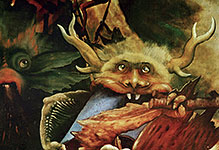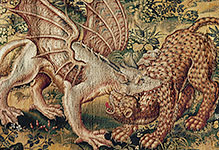
Mythology
Mythology

#03010243
Book of the Dead: The papyrus of Hunefer. Above Hunefer kneeling before a table...

#03010246
Book of the Dead: Papyrus of Heruben. (Book of the Dead - collection of funerar...

#03010249
Coptic textile (linen and wool) showing a nilometer. Nereids and putti are depi...

#03010252
North portal of the Baouit-chapel. Carved stone, Corinthian capitals. The lint...

#03010253
North portal of the Baouit-chapel. Carved stone, Corinthian capitals. The lint...

#03010255
Coptic textile,fabulous animal. 10 x 11 cm

#03010256
Textile,showing Artemis and Aktaion, from Akhmin,Egypt, Coptic Period, 4th.The...

#03010270
"Head of the colossal sphinx", Egypt, around 1801. From "Views in Egypt, Palest...

#03030155
Clay mask of the demon Humbaba, 1800-1600 BCE. One method for predicting the fut...

#03030211
Stone bowl from Khafajeh, Iraq, Early Dynastic period, c2600-c2400 BC. The carvi...

#03030222
Centaur and fish 244-245 CE; ceiling of the large hall of the synagogue, Salhiy...

#03030258
Falcon-headed sphinx from the large temple of Ramses II at Abu Simbel. Limestone...

